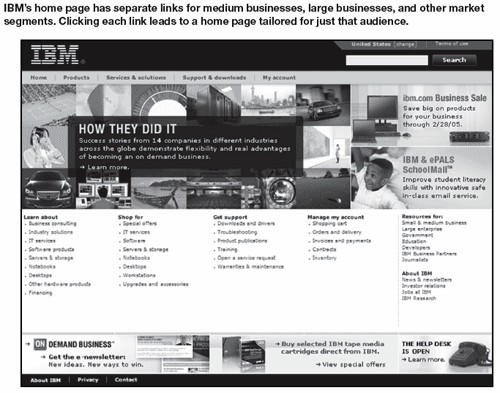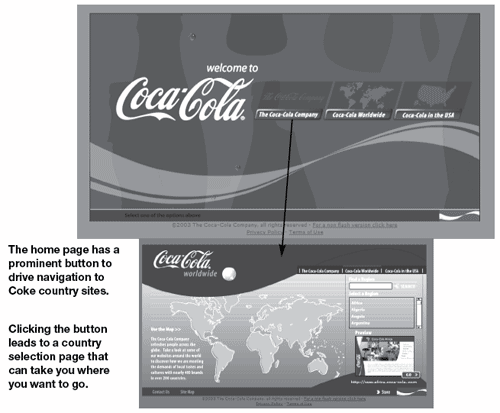The Challenge of Search Success
| Now that you know the basics of Web search, and you know how big a marketing opportunity it is, it must be time for a reality check: Search marketing is not easy to do. And, unlike most marketing efforts, the bigger you are, the harder it is. We know that in marketing, size has inherent advantages. The bigger the budget, the more advertising you can buy, the more free media coverage you can coax, the better a public relations person you can hire, and on and on. But search marketing is different. Companies with well-known brand names assume it is easy for their Web site to rank highly in search results, but John Tawadros (of search marketing firm iProspect) explains that "the field is more equal. Just because you're a big name doesn't mean much to the search engines." In fact, well-known brands have lots of competition for search rankings, both from their competitors and from their alliesmany resellers rank highly for well-known brands. Amazon may rank well when a searcher searches for "sony dvd player"possibly even higher than Sony's Web site. It is actually easier in some ways for small Web sites to succeed in search marketing than large ones. For instance, fewer people need to know what to do, and the whole Web site is managed one way by one team. As soon as your site is large enough that you hear some telltale conversations about separating your team or even your site into multiple parts, then search marketing has just gotten tougher:
Make no mistakethose preceding conversations are actually the sweet sound of success! Your Web site has grown too large to be run in the old simple way. Good for you that your site is growing and needs to be managed differently, but it makes search marketing much more diffi cult, for many reasons. Let's look at each of these situations and see what can go wrong for search marketing. Multiple Specialist TeamsAs soon as your Web team grows to more than about a dozen employees, people will start thinking about splitting the group into multiple teams and eventually several departments. No matter how you split things up, you will start to see communication problems that did not exist before. If you divide the group by specialties, maybe the Webmasters, JavaScript programmers, and system administrators go into the Web technology group, and HTML coders, copy writers, and graphics artists form a Web creative group. That works well for most tasks, because, for example, each copy writer can work closely with the other copy writers to set standards and ensure that the writing is consistent across the site. Unfortunately, search marketing gets more difficult precisely because it cannot be handled solely as a specialty. Your specialists must understand what they are personally required to do to make your search marketing a success. Your JavaScript programmers must place their code in files separate from the HTML files. Your copy writers must use the right words in their copy. Your Webmasters must choose the right naming convention for your pages' URLs (Uniform Resource Locatorsthe Web page addresses that start with www). The key point you need to understand is that search marketing is a team effort and that medium-to-large Web sites have multiple teams that must work together for your search marketing to succeed. Oh, and one more thing: None of these specialists will be focused on search marketingthat's your biggest challenge. Multiple Product SitesYour organization might be so highly decentralized that your customers do not even think of your separate products as coming from the same company. How many of you know that Procter & Gamble make Crest toothpaste, as well as the Cheer, Gain, and Tide laundry detergents? And how many even care? P&G's customers do not need to know what company makes these productsthey know the brand names, and that is enough. And if they need to learn more about the new whitening ingredient in Crest, they are much more likely to go to www.crest.com than www.pg.com. So, Procter & Gamble created separate Web sites for each major brand, as shown in Figure 1-15. Figure 1-15. Multiple product sites. Three Procter & Gamble laundry detergent home pages look like they are from completely separate companies. And each Web site might get its own team. There might be a Crest Webmaster, a Cheer Webmaster, a Gain Webmaster, and a Tide Webmaster, with the other specialists divided by product, too. Multiple product sites foster excellent communication among the specialists assigned to each product, but can create a situation in which there may be almost no communication across products. For most Web tasks, this might not be problematic, but for search marketing, it can be. The Tide, Cheer, and Gain sites should each be found when searchers look for "laundry detergent"but the respective teams might be fighting over those searchers rather than working together. To lead search marketing across P&G, you must coax these disparate product groups to sometimes collaborate instead of always competing. Perhaps they should team up to create the ultimate "laundry detergent" page that showcases each of their products. This is harder to pull off than it sounds, because collaboration might violate the competitive corporate culture. Alternatively, the three detergent marketers might pool their search knowledge so they each rank in the top ten. Moreover, this technique squeezes some competitors off the front page (because P&G has three listings out of ten). P&G marketers might warm to this approach because it is similar to how they stock supermarket shelves with multiple products to control the shelf space. None of these separate Web teams need to collaborate for other Web tasks; for search marketing, however, they dothat's your problem. Multiple AudiencesPerhaps your company is highly customer-centric, conducting all sales and marketing based on audiences, or market segments. So, you have a Web site for large business customers, another for small-to-medium customers, and a third for consumers, even though they buy many of the same products. Of course, each of these sites can be run by separate teams that might not need to work together with the other sites' teams. (Are you starting to see a pattern here?) Separate, audience-focused Web sites can be an effective way to communicate with your customers, because you can tune your marketing message to each audience's unique needs. Large businesses might want more customized service, whereas smaller firms might be willing to take a one-size-fits-all solution to their problemthese differing needs can be addressed with somewhat different offerings that are described differently on your Web site. IBM sells the same computer software and servers to several different audiences, but large customers might have negotiated special pricing based on volume and special configurations, whereas small customers are more interested in ease of installation and service. So, the same underlying technology might be sold à la carte to large businesses but as a packaged "solution" to small businesses. To follow through on this strategy, IBM offers large customers discounted pricing in one part of its site, and markets solutions to smaller businesses elsewhere, as shown in Figure 1-16. Figure 1-16. Multiple audience sites. IBM uses different marketing messages for different audiences, with a different area of its Web site for each. And dividing this Web site based on customer size usually works welluntil you consider search marketing. Unfortunately, when a prospective IBM customer searches for "Web commerce" in Google, there is no way to know whether the searcher has a small Web site that needs a turnkey solution or is from a large company wanting to purchase and run its own commerce software on its server. Neither the large company group nor the small company solution group is focused on search marketing, and sosay it with me now"you will have to do that." Multiple Countries
But this clever organizational idea, once again, hurts search marketing efforts. Some searchers use country-specific search engines, but many use global search engines, such as Google. What happens when a Canadian searcher enters "four-slice toaster" into the global search engine? Google might be able to determine the language of the query as English, but there may be excellent English-language pages on toasters in the United Kingdom, Australia, Canada, the United States, and many other countries. Your company might also have excellent matches for all of those countrieseach toaster page is similar to those in the other countries, but is specific to the country. (It shows the toaster that conforms to UK electrical standards and is priced in British pounds, for instance.) Google might just show the UK pages, even though it is not the one the Canadian searcher wants, and suppress the rest as being "similar pages." If the wrong country page displays, your visitor cannot buy your product easilyhe might be asked to pay in British pounds when he has Canadian dollars in his wallet. You can see that if your corporate Web site is divided by country, you might find Web teams responsible for different countries battling to capture searchers with the same querythey want their pages to "win" so that your other country pages are the ones suppressed. Worse, you might have well-known brand names, such as Coke, that are used in many countries regardless of language. How do you know which country those searchers want? Figure 1-17 shows how Coca-Cola handles this problem on its home page, but your company could face this problem for hundreds of brand names that cannot all be listed on your home page. Figure 1-17. Handling country sites. Coca-Cola highlights country selection on its home page to get searchers and other visitors to the right place. Once again, there may be no incentive within your company for different country teams to collaborate on search marketingthey are not required to work together on most other things. All together now: "It's your job." Multiple TechnologiesUntil now, this discussion has focused on the problems of multiple Web teams driven by the choices your company has made about how to organize. However, another problem grows as Web sites grow: the technology menagerie. A Web site can employ a dizzying array of technology:
Each of these components (and more) needs to be carefully configured to support your search marketing efforts. This configuration is complicated when your Web site has been pieced together across a large organization, however, because your site probably uses different components in each part of the site. So, your multiple product sites (or audience sites or country sites) might each have its own team using different technologies to run each site. In the initial rush to get every part of your company on the Web, a divide-and-conquer strategy might have ruled the day, with each division doing its own thing. Unfortunately, you are paying for that now, because every combination of technology that displays a Web page must be configured properly to make search marketing work. The more technology combinations you have, the harder it is to get them all working for search. Frequently, you need to coordinate multiple changes to fix one problem because, for example, the content management system and the portal are both contributing causes. And (by now you are waiting for it), none of these technical specialists will think search marketing is part of their jobit is your job to get them to fix each problem. If you find that your Web site suffers from the technology menagerie or any of the other problems listed here, don't despair. We show you how to solve each one. |
EAN: 2147483647
Pages: 138